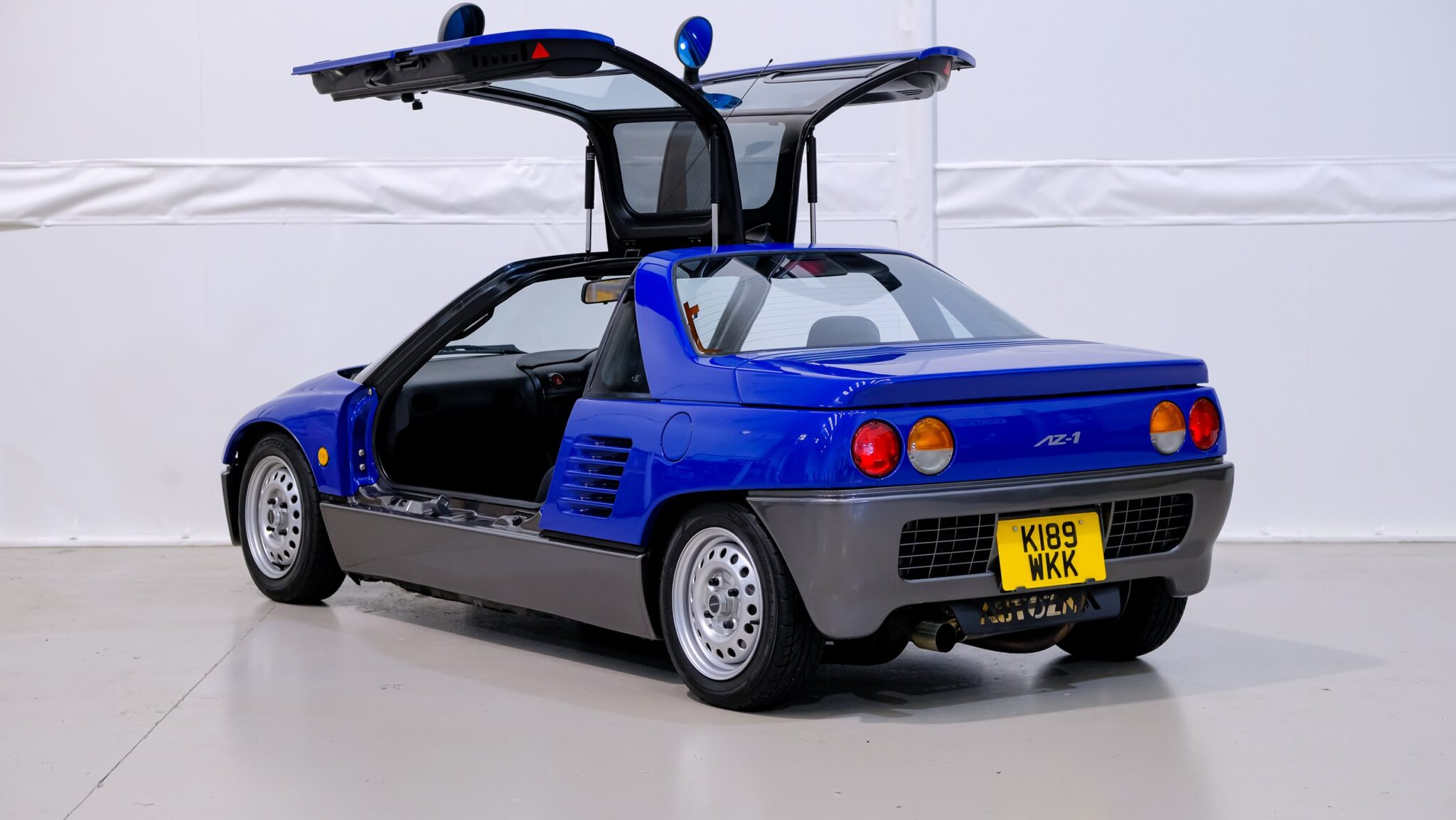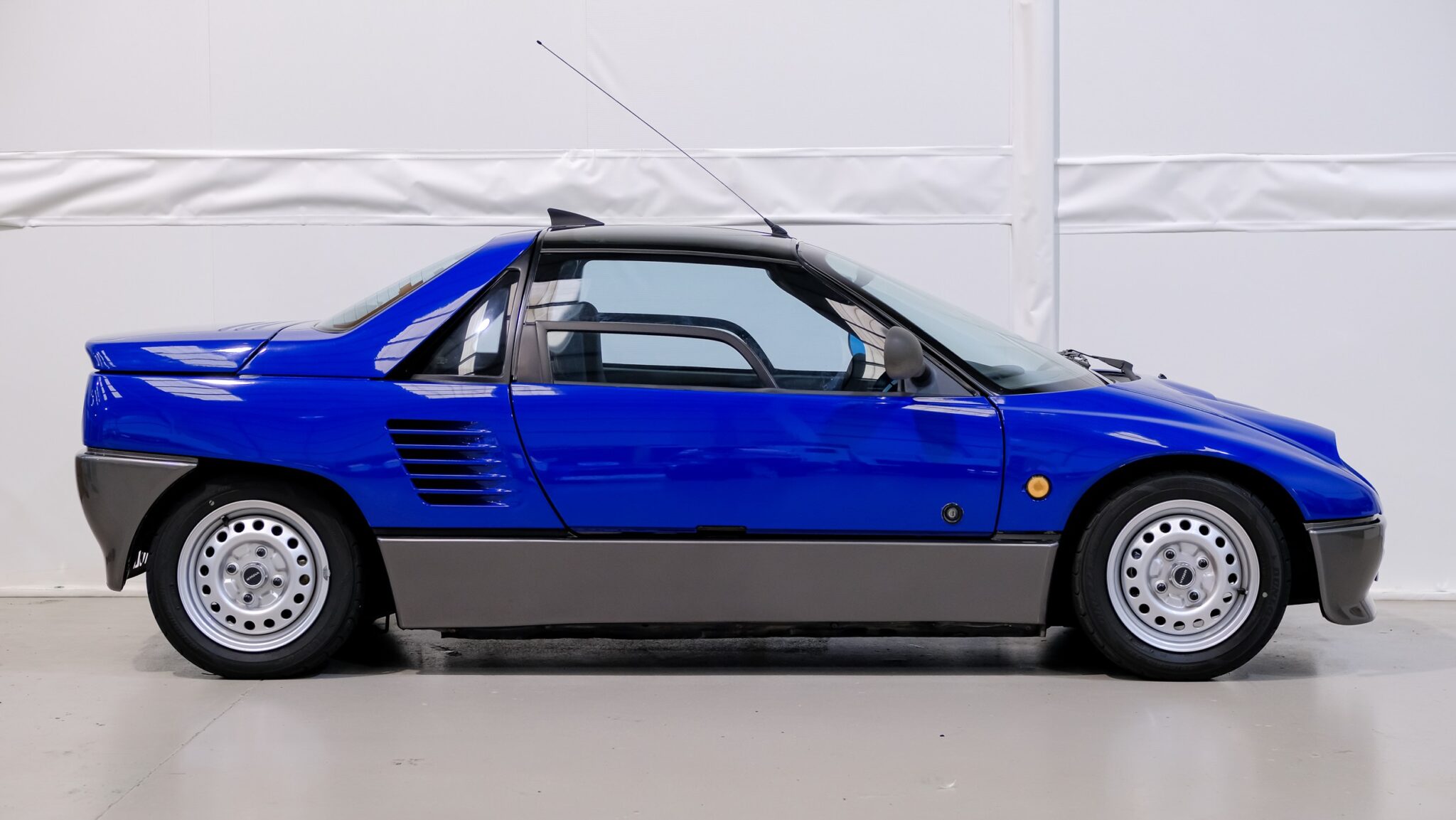
Mazda Autozam AZ-1 is one of the most fascinating Japanese kei cars of the 1990s, blending the spirit of supercars with compact dimensions. Its story began in the mid-1980s, when Mazda decided to create a car that was stylish, sporty, and aimed at young drivers. Initially, the project was developed by Suzuki as the RS/1 (1985) and RS/3 (1987) concepts, but Mazda later took the idea and adapted it for its Autozam brand, known for compact vehicles.
The design was led by Takao Kido and Nobuo Igarashi, who aimed to give the car a futuristic look and a sporty character. The gullwing doors became the AZ-1’s signature feature, adding a supercar charm reminiscent of Ferrari or the Mercedes-Benz 300SL. Despite the restrictions of the kei car category, the designers managed to give the model an aggressive appearance, with elements inspired by the Ferrari 308 GTB.
However, the path to production was not easy. Mazda faced technical challenges, particularly the need to improve chassis stability. Additionally, Japan’s economic crisis delayed the car’s launch until 1992. While the Mazda Autozam AZ-1 had significant potential and stood out with its design, its high price and niche concept prevented it from achieving mass appeal. Only 4,392 units were produced, and today, the AZ-1 is a sought-after collector’s item worldwide.
Read too: From Dream to Legend: The Story of Lotec

Specifications of Mazda Autozam AZ-1
1. Power: 64 hp (47 kW) at 7,500 rpm
2. Acceleration: 0-100 km/h in approximately 8.0 seconds
3. Top Speed: 140 km/h
4. Engine: 0.66-liter 3-cylinder turbocharged engine
5. Range: Approximately 400 km (depending on driving style and conditions)
6. Dimensions: Length – 3,295 mm, Width – 1,395 mm, Height – 1,125 mm, Wheelbase – 2,215 mm
7. Technologies: Turbocharging, lightweight body construction, front-wheel drive, 5-speed manual transmission
8. Additional Features: Gullwing doors, sporty design, air conditioning, power windows, sports seats.
Read too: Mega Track: The Story Behind the Car that Combines Speed and Off-Road Capability

Why Mazda Autozam AZ-1 Didn’t Achieve Global Popularity?
Mazda Autozam AZ-1 is undoubtedly one of the most unique cars ever created by Japanese engineers in the 1990s. With its futuristic design, gullwing doors, and sporty nature, it was captivating. However, despite all its innovation, AZ-1 didn’t manage to gain worldwide popularity. Though it has since become a cult car among collectors, its commercial failure remains a mystery. What caused this car, which seemed to deserve worldwide acclaim, to fail?
Autozam AZ-1 was developed as part of Japan’s kei car concept – small, economical vehicles that were meant to be ideal for urban life. However, unlike other kei cars, the AZ-1 was sporty and attempted to carve its niche in the “miniature sports car” category.
Despite its technical innovations, such as the use of modern materials and aerodynamic design, AZ-1 had several weaknesses. Its limited engine power and the small number of units produced meant it couldn’t compete with other sports cars of its time, such as the Honda Beat or Suzuki Cappuccino, which enjoyed higher demand on the market.
One of the main factors behind Mazda Autozam AZ-1‘s commercial failure was its focus on the Japanese market. While the car was perfect for Japanese urban conditions, it didn’t meet the needs of international markets. AZ-1 wasn’t as practical for countries that preferred larger, more comfortable cars, and as demand for more versatile models grew, AZ-1 found it difficult to compete. Furthermore, its limited production run meant that many potential buyers never had the chance to own this unique vehicle.
Mazda, despite its innovative approach to the AZ-1, failed to build the right marketing strategy for the model. A small advertising budget and limited distribution left the car virtually unknown outside Japan. Other Japanese manufacturers, at the time, took more massive steps to promote their models, with Honda’s Beat being more successful in garnering international attention.
The Autozam AZ-1 was more than just a car; it was an attempt by Mazda to create a unique product that could become a “mini supercar” accessible to the masses. Its design and concept made it intriguing and exciting, but the commercial execution wasn’t quite right. As a result, this model remained “underrated” compared to other sports cars of the time.
However, decades after its production ended, the Mazda Autozam AZ-1 has achieved cult status among Japanese car enthusiasts. Today, it’s not just a rare vehicle, but also a symbol of how innovative ideas can have tremendous potential, even if they don’t become commercial hits.
Read too: Top 5 the Most Beautiful Italian Supercars

Mazda Autozam AZ-1 was packed with interesting technologies, making it stand out among other kei cars of its time. While it may have been a commercial failure, the car was full of forward-thinking features that showcased Mazda’s innovative spirit. Here are four notable technologies that made the AZ-1 unique:
1. Gullwing Doors: One of the most iconic features of the Mazda Autozam AZ-1 was its gullwing doors, which opened upwards like the wings of a bird. These doors not only gave the car a futuristic and exotic look but also provided practical benefits in cramped parking spaces, making it easier to get in and out of the car. At the time, the use of gullwing doors in a kei car was a bold and unusual design choice that set the AZ-1 apart from other vehicles in its class.
2. Mid-Engine Layout: The AZ-1 utilized a mid-engine layout, with the 657cc engine placed just behind the driver. This setup provided excellent weight distribution, resulting in improved handling and stability. The mid-engine design is typically found in more expensive sports cars and supercars, so seeing it in a kei car like the AZ-1 was a remarkable feature that contributed to its sporty character.
3. Lightweight Construction: Mazda employed lightweight materials to keep the AZ-1 as nimble and agile as possible. The car’s body was made from a combination of steel and composite materials, including fiberglass and plastic, helping reduce its overall weight. This not only improved performance but also made the AZ-1 more fuel-efficient, which was essential for a kei car.
4. Advanced Aerodynamics: Mazda engineers paid close attention to the AZ-1’s aerodynamics, incorporating features like a low, wide stance and sculpted body panels. The car’s design helped reduce drag, allowing it to achieve better fuel efficiency and performance. The AZ-1’s aerodynamic efficiency was impressive for a car in the kei car category, helping it deliver a more stable ride at higher speeds, especially considering its compact size.
These technologies made the Mazda Autozam AZ-1 more than just a simple kei car. They combined to create a vehicle that was ahead of its time in terms of design, performance, and driving experience, even though the car never gained widespread commercial success.
Read too: Kia Tasman looks like the “Tasmanian devil” – the horror from Kia
conclusion:
Mazda Autozam AZ-1, despite its commercial failure, left a significant mark in the history of the automotive industry. This small sports car, with its futuristic design and innovative technologies like gullwing doors, mid-engine layout, and lightweight construction, was a testament to engineering craftsmanship and bold decisions. Although the AZ-1 did not gain popularity in international markets, its unique features continue to attract the attention of collectors and car enthusiasts. Ultimately, the Mazda Autozam AZ-1 remains a cult symbol of how innovations can face challenges in the commercial world but always find fans among those who appreciate true automotive design and technology.


Future Classics: 10/10
Brand Recognition: 8/10
Design Modernity: 9/10
CarsCorn Score: 9/10